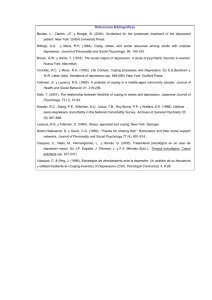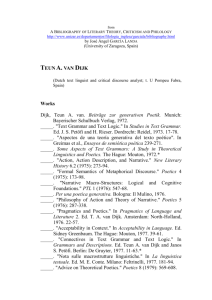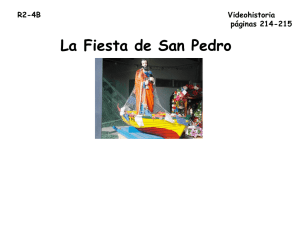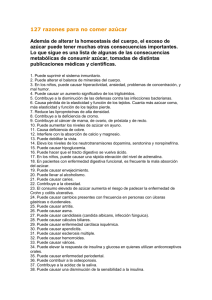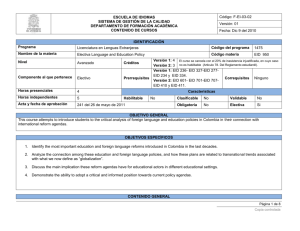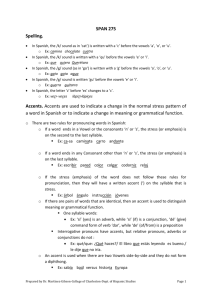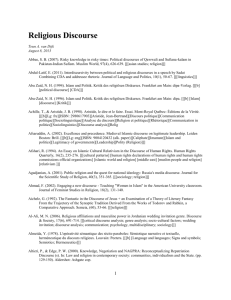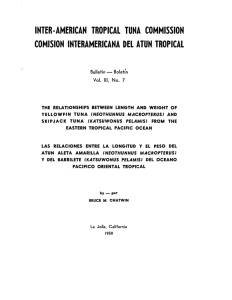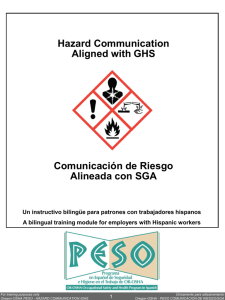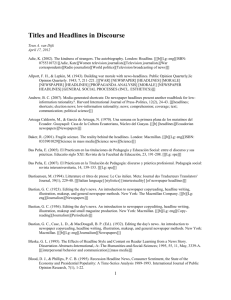Graffiti - Discourse in Society
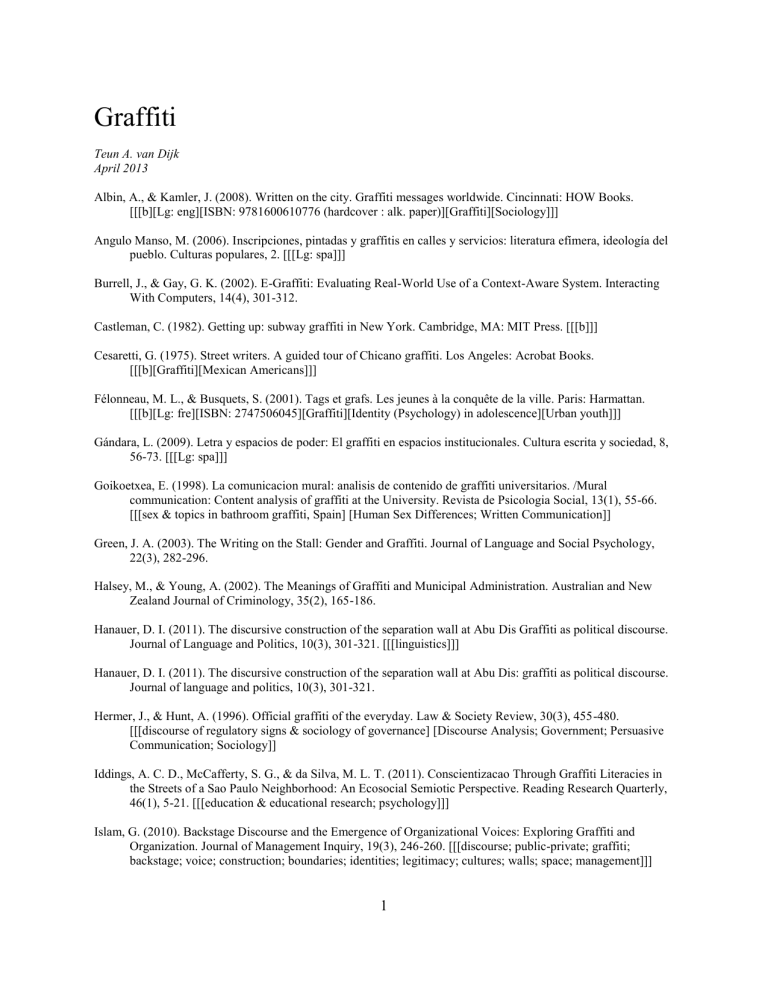
Graffiti
Teun A. van Dijk
April 2013
Albin, A., & Kamler, J. (2008). Written on the city. Graffiti messages worldwide. Cincinnati: HOW Books.
[[[b][Lg: eng][ISBN: 9781600610776 (hardcover : alk. paper)][Graffiti][Sociology]]]
Angulo Manso, M. (2006). Inscripciones, pintadas y graffitis en calles y servicios: literatura efímera, ideología del pueblo. Culturas populares, 2. [[[Lg: spa]]]
Burrell, J., & Gay, G. K. (2002). E-Graffiti: Evaluating Real-World Use of a Context-Aware System. Interacting
With Computers, 14(4), 301-312.
Castleman, C. (1982). Getting up: subway graffiti in New York. Cambridge, MA: MIT Press. [[[b]]]
Cesaretti, G. (1975). Street writers. A guided tour of Chicano graffiti. Los Angeles: Acrobat Books.
[[[b][Graffiti][Mexican Americans]]]
Félonneau, M. L., & Busquets, S. (2001). Tags et grafs. Les jeunes à la conquête de la ville. Paris: Harmattan.
[[[b][Lg: fre][ISBN: 2747506045][Graffiti][Identity (Psychology) in adolescence][Urban youth]]]
Gándara, L. (2009). Letra y espacios de poder: El graffiti en espacios institucionales. Cultura escrita y sociedad, 8,
56-73. [[[Lg: spa]]]
Goikoetxea, E. (1998). La comunicacion mural: analisis de contenido de graffiti universitarios. /Mural communication: Content analysis of graffiti at the University. Revista de Psicologia Social, 13(1), 55-66.
[[[sex & topics in bathroom graffiti, Spain] [Human Sex Differences; Written Communication]]
Green, J. A. (2003). The Writing on the Stall: Gender and Graffiti. Journal of Language and Social Psychology,
22(3), 282-296.
Halsey, M., & Young, A. (2002). The Meanings of Graffiti and Municipal Administration. Australian and New
Zealand Journal of Criminology, 35(2), 165-186.
Hanauer, D. I. (2011). The discursive construction of the separation wall at Abu Dis Graffiti as political discourse.
Journal of Language and Politics, 10(3), 301-321. [[[linguistics]]]
Hanauer, D. I. (2011). The discursive construction of the separation wall at Abu Dis: graffiti as political discourse.
Journal of language and politics, 10(3), 301-321.
Hermer, J., & Hunt, A. (1996). Official graffiti of the everyday. Law & Society Review, 30(3), 455-480.
[[[discourse of regulatory signs & sociology of governance] [Discourse Analysis; Government; Persuasive
Communication; Sociology]]
Iddings, A. C. D., McCafferty, S. G., & da Silva, M. L. T. (2011). Conscientizacao Through Graffiti Literacies in the Streets of a Sao Paulo Neighborhood: An Ecosocial Semiotic Perspective. Reading Research Quarterly,
46(1), 5-21. [[[education & educational research; psychology]]]
Islam, G. (2010). Backstage Discourse and the Emergence of Organizational Voices: Exploring Graffiti and
Organization. Journal of Management Inquiry, 19(3), 246-260. [[[discourse; public-private; graffiti; backstage; voice; construction; boundaries; identities; legitimacy; cultures; walls; space; management]]]
1
Joswig-Mehnert, D., & Yule, G. (1996). The Trouble with Graffiti. Journal of English Linguistics, 24(2), 123-130.
[[[graffiti] [intelligibility] [communicative function of language] [nonverbal communication] [art as language]]]
Kacandes, I. (1994). Narrative Apostrophe, Reading, Rhetoric, Resistance in Michel Butor La `Modification' and
Julio Cortazar `Graffiti'. Style, 28(3), 329-349.
Kirsch, H. W. (1995). Taking the message to the streets: Graffiti campaigns and community mobilization. In:
Kirsch, Henry W. (Ed.), Drug lessons & education programs in developing countries. (pp.263-270). New
Brunswick, NJ: Transaction. [[[community mobilization effort in graffiti campaigns for drug-abuse prevention] [high risk populations] [Bolivia and Brazil and Mexico]]]
Lachmann, R. (1988). Graffiti As Career and Ideology. American Journal of Sociology, 94, 229-250.
Lasley, J. R. (1995). New writing on the wall: Exploring the middle-class graffiti writing subculture. Deviant
Behavior, 16(2), 151-167. [[[subculture anthropological] [middle class] [written language] [adulthood] ]]
Loewenstine, H. V., Ponticos, G. D., & Paludi, M. A. (1982). Sex differences in graffiti as a communication style.
Journal of Social Psychology, 117(2), 307-308. [[[communicative topics of graffiti in male vs female restrooms, implications for manifestations of power differences between sexes] [Human Sex Differences;
Power; Verbal Communication; Written Language]]
Lucca, N., & Pacheco, A. M. (1986). Childrens Graffiti: Visual Communication from a Developmental
Perspective. Journal of Genetic Psychology, 147(4), 465-479.
Lucca Irizarry, N., & Pacheco Maldonado, A. M. (1983). El estudio de los Graffiti como fuente para la investigacion en la psicologia social evolutiva: Un examen de la literatura. /The study of graffiti as a source for research on developmental social psychology: A review of the literature. Perspectivas en Psicologia,
2(1-2), 57-82. [[[sex differences, graffiti & person-environment relationships, literature review] [Human
Sex Differences; Literature Review; Psychosocial Development; Vandalism]]
Lussu, G. (1998). La lettera uccide. Viterbo, Italy: Stampa Alternativa & Graffiti.
Luzzatto, D., & Jacobson, Y. (2001). Youth graffiti as an existential coping device: The case of Rabin's assassination. Journal of Youth Studies, 4(3), 351-365. [[[symbolic meaning] [graffiti] [Israeli adolescents]
[coping strategies]]]
Martín Fernández, C. (Ed.). (1995). Psicología política identidad y emigración. Montevideo, Uruguay: Editorial
Graffiti. [[[b] [Cuban Americans; Emigration and immigration; Immigrants; Political psychology.]]]
Miklavcic, A. (2008). Slogans and graffiti: Postmemory among youth in the Italo-Slovenian borderland. American
Ethnologist, 35(3), 440-453. [[[anthropology]]]
Millie, A. (2008). Anti-social behaviour, behavioural expectations and an urban aesthetic. British Journal of
Criminology, 48(3), 379-394. [[[graffiti; crime; city; criminology & penology]]]
Moreau, T., & Alderman, D. H. (2011). Graffiti Hurts And The Eradication Of Alternative Landscape Expression.
Geographical Review, 101(1), 106-124. [Lg: English][[[[Discourse] [Graffiti Hurts] [Landscape inscription]
]]]
Mosquera, A., & Djukich de Nery, D. (2001). El espacio oculto del discurso del graffiti en las salas sanitarias universitarias. Opción: Revista de Ciencias Humanas y Sociales, 36, 48-67. [[[Lg: spa]]]
Nayak, A. (2010). Race, affect, and emotion: young people, racism, and graffiti in the postcolonial English suburbs. Environment and Planning a, 42(10), 2370-2392. [[[cultural-geography; countryside; whiteness; identity; politics; place; ; environmental studies; geography]]]
2
Neef, S. (2007). Killing kool: the graffiti museum. Art History, 30(3), 418-+. [[[art]]]
Nierenberg, J. (1983). Proverbs in Graffiti: Taunting Traditional Wisdom. Maledicta, 7, 41-58. [[[sociolinguistics]
[discourse analysis] [word play games] ]]
Nilsen, D. L. F. (1978). Graffiti vs Doublespeak: The Anti-Establishment Strikes Back. English Journal, 67(2), 20-
25. [[[mass media] [sociolinguistics] [discourse analysis] ]]
Nwoye, O. G. (1993). Social issues on walls: graffiti in university lavatories. Discourse & Society, 4(4), 419-442.
Otta, E., Santana, P. R., Lafraia, L. M., & Hoshino, R. L., et al. (1996). Musa latrinalis: Gender differences in restroom graffiti. Psychological Reports, 78(3, Pt, 1) 871-880. [[[age differences][human sex differences][vandalism][written communication]]]
Pani, R., & Sagliaschi, S. (2009). Psychopathology of Excitatory and Compulsive Aspects of Vandalistic Graffiti.
Psychological Reports, 105(2)(3), 1027-1038. [[[sex-differences; risk; everyday; gender; psychology, multidisciplinary]]]
Plasencia Soto, R., & Universidad Nacional Mayor de San Marcos. (2003). Sujeto de la antropología. Artículos incorregibles e imposibles de publicar. Lima, Perú: Seminario de Historia Rural Andina, Universidad
Nacional Mayor de San Marcos. [[[b][Lg: spa][ISBN: 9972970817][Anthropology][Graffiti]]]
Poveda, D. (2012). Literacy Artifacts and the Semiotic Landscape of a Spanish Secondary School. Reading
Research Quarterly, 47(1), 61-88. [[[space; neighborhood; perspectives; education; graffiti; language; youth; time; life; education & educational research; psychology]]]
Puig, R. (2005). Barcelona 1000 Graffitis. Barcelona: Editorial Gustavo Gili S.L..[[[b] [Lg: Spa]]]
Reuter, M., Scholz, M., Limesmuseum Aalen., & Archõlogisches Landesmuseum Baden-Wrttemberg. (2004).
Geritzt und entziffert. Schriftzeugnisse der rmischen Informationsgesellschaft. Stuttgart: Theiss. [[[b][Lg: ger][ISBN: 3806219249 (pbk.)][Writing][Graffiti][Literacy]]]
Romotsky, J., & Romotsky, S. R. (1976). Los Angeles barrio calligraphy. Los Angeles: Dawson's Book Shop.
[[[b][Graffiti][Calligraphy][Mexican Americans]]]
Scheibel, D. (1994). Graffiti and Film School Culture: Displaying Alienation. Communication Monographs, 61(1),
1-18.
Schnitzer, J. (1994). Relaciones de coherencia entre texto verbal e imagen en pintadas politicas. Supostavitelno
Ezikoznanie Sopostavitel'noe Jazykoznanie Contrastive Linguistics, 19(1), 35-45. [[[Spanish language]
[Catalonia] [stylistics] [political graffiti]]]
Schwender, D. (2008). Promotion of the arts: An argument for limited copyright protection of illegal graffiti.
Journal of the Copyright Society of the Usa, 55(2-3), 257-282. [[[law]]]
Waterhouse, J., & Penhallow, D. (2006). Arte skater.: Del graffiti al lienzo. Barcelona: Editorial Gustavo Gili
S.L..[[[b] [Lg: Spa]]]
Watson, T. S. (1996). A prompt plus delayed contingency procedure for reducing bathroom graffiti. Journal of
Applied Behavior Analysis, 29(1), 121-124. [[[contingency management][vandalism][written communication][longitudinal studies]]]
3
